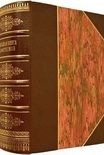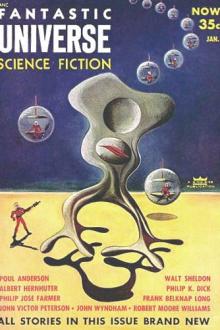The Fourth Child, Jessica Winter [fantasy novels to read txt] 📗

- Author: Jessica Winter
Book online «The Fourth Child, Jessica Winter [fantasy novels to read txt] 📗». Author Jessica Winter
“Bastard did the same thing—”
“Pat, watch your language,” Mom said.
“—he did the same thing with the last chestnut,” Dad said, “on the other side of his property, on the line with the Stedmores.The very last chestnut tree for miles and miles. You know, a long time ago, Mirela, there were chestnut trees all over theplace. Their flowers were white, and when they fell in the spring it was like a second snow. Now it’s just the cottonwoods,with the cobwebby kind of snow. You know those? Anyway, that imbecile went ahead and cut down that chestnut one day, needledand needled Bill Stedmore about it day after day, week after week, and Bill held firm, and even still, one day O’Toole wentand goddamn did it.”
“Pat, come on with the language,” Mom said.
“He just went and did it. And then I guess it was my turn with the beech.”
Mirela told Dad that he should call the police on Mr. O’Toole. Mom and Dad laughed quietly like it was a funny secret.
“I should call the police, Mirela,” Dad said, “but I want to go easy on the guy.”
“You should call the police,” Mirela said, “and then they’ll send Mr. O’Toole to Colorado.”
And then Dad was looking at Mom like the light from his eyes could explode her and Mom was talking in a high, pulling voiceabout how heavy the cottonwood snow had been this past year and Mirela started laughing like they had been just a moment before,making noise to fill the dizzy space that had opened up between them.
She doesn’t remember much of Colorado anymore. Maybe she dreamed it. In the memory or the dream, they hold her down. The goodthing about being held down was that it meant the day was close to finished—it was what they did when they were almost donewith her. The last day of all was different because they started with holding her down. That was how she knew it would bea short day.
Now the beech was something that was destroyed and still lived. A beech needs a lot of space to grow, and maybe this one didnot have enough space to die. The tree had ended, and then there were the beginnings of the same tree. Splinters and shardsfrom the top of the stump had scattered, pushing outward into a crooked semicircle, like voles or stoats had begun stackingthe fragments as cords of firewood. One corner of the stump was hollowed out like a cave, with crags of bark hanging downlike stalactites and strung with lichens. Moss bloomed on the bark, and toadstools lined the entrances to a pair of rabbitwarrens, dug in the soft earth. A teetering mushroom stalk shot up nearly to Mirela’s knee. A half-dozen green vertical shootsgrew even taller, fanned with wide green leaves. These were the root suckers, like baby versions of the tree, copies, madeout of a knot of tissue from the base of what had been the tree. You could almost kill the tree—basically kill it—and it wouldstart itself over from almost nothing. You didn’t need a seed or a flower.
It was Dad who explained all of these things to her. His company was clearing some woods near Klein Road to build new houses, and some mornings, Mirela drove with him to the site in the red pickup truck. If they got up before anyone else in the house, arrived at the site by sunrise, they could usually see deer. Where their house is now used to be woods, too. You can tell which trees are the oldest because they are taller than the rest, and their branches start higher up, because they had to compete with so many other trees for space, reaching toward the sunlight and rain.
Dad knows all the names of the trees and plants and flowers and tells them to Mirela. She only has to hear each name twice,maybe three times, and then she remembers it always. You can learn all the trees, and you can also look at a leaf on its own,and then look up around you, and you’ll know which tree the leaf belongs to, because this one has round, heart-shaped leaves,or that one has slender leaves edged with little spikes, like teeth.
She likes kneeling in the soil in the morning, when it’s still dewy and her knees go cold. From the ground beneath the easternwhite pine, Mirela gathers the pine cones and brings them home and glues them to construction paper, and she decorates themwith paint and glitter. She gathers chestnuts and paints faces on them: smiling, sad, mad. Hickory trees have catkins, longdroopy green flowers that look like caterpillars, and she brings those home, too. Same with the twigs of the eastern hemlock,which sprout blades of grass and look like tiny, doll-sized fans. They go in the big shoebox, the one that Mom’s winter bootscame in, with the caterpillars and the pine cones.
Mirela wanted the red buds from the dogwood, but none had fallen yet. You can’t just take what you want off a tree—the tree has to decide to shed it first. The female cottonwood trees first make red flowers, like a dogwood, and then seeds with a cotton covering. She didn’t mind the cobwebs of cotton that blew around in May and June—Mom and Dad didn’t like how the cotton clogs the drains and gets in between the bricks on the patio. Mirela uses handfuls of cotton to keep her caterpillars cozy at night.
If you climb a tree, it will move with you—it shifts with your weight. If you slip on a tree, the branch will suddenly feelwider and denser than before; it will seem to sprout little knots and ridges, giving you more traction. It breathes with youand makes up for your mistakes. Your arms and legs start to feel a little harder, thicker, like you’re becoming a part ofit. Sometimes she scrapes her hands and arms on the bark of trees, but it doesn’t hurt. The





Comments (0)